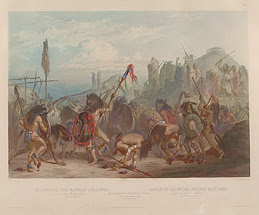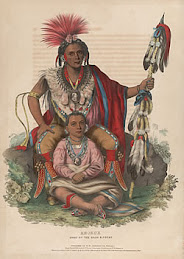Dana Tiger
http://www.artnatam.com/dtiger/index.html
Jerome Bushyhead
http://www.artnatam.com/bhead/index.html
Thursday, May 14, 2009
Websites/Links
http://www.religioustolerance.org/nataspir.htm
- This website discusses religious tolerance, as the URL states, and describes Native American religious beliefs and practices, as well as European and Canadian treatment of Native Americans. I suggest this website to be read; it is very informative and eye-opening.
- Check out the FAQ
- "The arrival of Europeans marked a major change in Native society. Millions died due to sickness, and programs of slavery and extermination. 1 Europeans and their missionaries looked upon Native Spirituality as worthless superstition inspired by the Christian devil, Satan. Many of the survivors were forcibly converted to Christianity. The U.S. and Canadian governments instituted policies to force Natives onto reservations and to encourage them to become assimilated into the majority culture. 2 During the middle decades of the 20th century, whole generations of children were kidnapped, forcibly confined in residential schools, and abused physically, sexually and emotionally. In Canada, these schools were operated on behalf of the Federal Government by the Roman Catholic, Anglican, United and Presbyterian churches. Both the government and these religious institutions have settled a multi-billion dollar class-action lawsuit. Claims against the Anglican Church were much greater than the Church's current assets. The was a concern for a while that the church might be forced into bankruptcy due to legal costs.
Native spirituality was suppressed by the U.S. and Canadian governments. Spiritual leaders ran the risk of jail sentences of up to 30 years for simply practicing their rituals. This came to an end in the U.S. in 1978 when the Freedom of Religion Act was passed.
Some suicidologists believe that the extremely high suicide rate among Natives is due to the destruction of their religion and culture by the Federal Governments. This suppression is still seen in the prison administrations; Canadian prisons have only recently allowed Native sweat lodge ceremonies; many American prisons routinely deny permission."
http://www.ipsl.org/programs/summer/southdakota.aspx
- Summer Service-Learning Program in the Lakota Nation, South Dakota
- Study Abroad integrated with Volunteer Service
http://www.sacred-texts.com/nam/index.htm
- This website discusses the lack of "authoritative information" on Native American religious/spiritual practices. A list of literary references is included, as well as entire books concerning Native Americans.
http://www.americanchronicle.com/articles/view/102102
- Native American Women Are Missing Out On Mammograms
- "...many Native American women are not being given regular diagnostic exams that include mammograms."
http://www.native-languages.org/kids.htm
- Very informative, as well as interesting.
- "The best-known episode in Cherokee history was also the worst: the Trail of Tears, the forced relocation of the Cherokee Indians from their ancestral home in the southeast to Oklahoma. The Cherokee people were an urban, Christian, agricultural, intermarried society who had supported the United States against other tribes. In the end this was all for nothing. Though prominent Americans like Davy Crockett and Daniel Webster spoke against Removal, and though the Supreme Court ruled it unconstitutional, President Andrew Jackson sent in the army. Fifteen to twenty thousand Cherokee Indians (along with Choctaw, Creek, and other tribes) were rounded up and herded to Oklahoma in the winter of 1838-1839. Driven from their homes without being allowed to collect their possessions first, even their shoes, the Cherokees were no better equipped for an 800-mile forced march than people today would be. Between four and eight thousand Cherokee people died of exposure, starvation, disease, and exhaustion along the Trail of Tears. If you understand this, both the extent to which the Cherokees had adopted American standards of civilization before the Removal and the ultimate futility of it, you will go a long way towards understanding the Cherokee mentality and also the attitudes of other Indian peoples towards us. "
http://www.lib.washington.edu/subject/history/tm/native.html#major
- Includes lists of websites which describe the history of Native Americans, as well as references for texts and images.
http://etext.virginia.edu/subjects/Native-American.html
- Lists of electronic texts
http://etext.lib.virginia.edu/toc/modeng/public/AleAmer.html
- Includes various poems concerning Native Americans
- Click on the link "Poem."
http://bancroft.berkeley.edu/Exhibits/nativeamericans/
- Native American images
http://edtech.kennesaw.edu/web/natam.html
- Research/informational sites
- Native American artists' home page
*more to be added soon
Books, courtesy of: religioustolerance.org
- Ward Churchill, "A Little Matter of Genocide: Holocaust and Denial in the Americas, 1492 to the Present," City Lights Books, (1998). Read reviews and/or order this book safely from Amazon.com's online bookstore
- Ward Churchill et. al., "Agents of Repression: the FBI's Secret Wars Against the Black Panther Party and the American Indian Movement." South End Press, (1988). Read reviews and/or order this book
- Vine Deloria, "Red Earth, White Lies: Native Americans and the Myth of Scientific Fact," Fulcrum Pub (1997). Read reviews and/or order this book
- T.D. Dillehay, "Monte Verde: A late Pleistocene settlement in Chile: The archeological context and interpretation," Smithsonian Institution Press, (1997). Read reviews or order this book. This is not an inexpensive book!
- Arlene B. Hirschfelder & Paulette Molin, "The Encyclopedia of Native American Religions: An Introduction," Facts on File, (1992). Read reviews or order this book
- Ake Hultkrantz & Monica Setterwall, "The Religions of the American Indians," University of California Press, (1981). Read reviews or order this book
- Lee Irwin, "Native American Spirituality: A critical reader," University of Nebraska Press, (2000). Read reviews and/or order this book
- Lawrence Sullivan, "Native Religions and Cultures of North America," Continuum International Publishing Group, (2003). Read reviews and/or order this book
- Dennis Tedlock & Barbara Tedlock, "Teachings from the American Earth: Indian Religion and Philosophy," Liveright Publishing Corporation, (1992). Read reviews and/or order this book.
Quotes, courtesy of: religioustolerance.org
"The culture, values and traditions of native people amount to more than crafts and carvings. Their respect for the wisdom of their elders, their concept of family responsibilities extending beyond the nuclear family to embrace a whole village, their respect for the environment, their willingness to share - all of these values persist within their own culture even though they have been under unremitting pressure to abandon them."
-Mr. Justice Thomas Berger, Mackenzie Valley Pipeline Inquiry, (aka the Berger Inquiry), Canada.
"Rather than going to church, I attend a sweat lodge; rather than accepting bread and toast [sic] from the Holy Priest, I smoke a ceremonial pipe to come into Communion with the Great Spirit; and rather than kneeling with my hands placed together in prayer, I let sweet grass be feathered over my entire being for spiritual cleansing and allow the smoke to carry my prayers into the heavens. I am a Mi'kmaq, and this is how we pray."
-Noah Augustine, from his article "Grandfather was a knowing Christian," Toronto Star, Toronto ON Canada, 2000-AUG-09.
"If you take [a copy of] the Christian Bible and put it out in the wind and the rain, soon the paper on which the words are printed will disintegrate and the words will be gone. Our bible IS the wind."
-Anonymous Native American woman
-Mr. Justice Thomas Berger, Mackenzie Valley Pipeline Inquiry, (aka the Berger Inquiry), Canada.
"Rather than going to church, I attend a sweat lodge; rather than accepting bread and toast [sic] from the Holy Priest, I smoke a ceremonial pipe to come into Communion with the Great Spirit; and rather than kneeling with my hands placed together in prayer, I let sweet grass be feathered over my entire being for spiritual cleansing and allow the smoke to carry my prayers into the heavens. I am a Mi'kmaq, and this is how we pray."
-Noah Augustine, from his article "Grandfather was a knowing Christian," Toronto Star, Toronto ON Canada, 2000-AUG-09.
"If you take [a copy of] the Christian Bible and put it out in the wind and the rain, soon the paper on which the words are printed will disintegrate and the words will be gone. Our bible IS the wind."
-Anonymous Native American woman
Thursday, April 30, 2009
Excerpt #1
"Yeah, you don't believe in the Ghost Dance, do you? Oh, you like its symbolism. You admire its metaphorical beauty, enit? You just love Indians so much. You love Indians so much you think you're excluded from our hatred. Don't you see? If the Ghost Dance had worked, you wouldn't be here. You'd be dust."
"Dr. Faulkner," Mather said. "Please put an end to this ridiculous digression."
But Faulkner, fascinated by Marie now, was silent.
"So maybe this Indian Killer is a product of the Ghost Dance. Maybe ten Indians are Ghost Dancing. Maybe a hundred. It's just a theory. How many Indians would have to dance to create the Indian Killer? A thousand? Ten thousand? Maybe this is how the Ghost Dance works."
"Ms. Polatkin, the Ghost Dance was not about violence or murder. It was about peace and beauty."
"Peace and beauty? You think Indians are worried about peace and beauty? You really think that? You're so full of shit. If Wovoka came back to life, he'd be so pissed off. If the real Pocahontas came back, you think she'd be happy about being a cartoon? If Crazy Horse, or Geronimo, or Sitting Bull came back, they'd see what you white people have done to Indians, and they would start a war. They'd see the homeless Indians staggering around downtown. They'd see the fetal-alcohol-syndrome babies. They'd see the sorry-ass reservations. They'd learn about Indian suicide and infant-mortality rates. They'd listen to some dumb-shit Disney song and feel like hurting somebody. They'd read books by assholes like Wilson, and they would start killing themselves some white people, and then kill some asshole Indians, too.
"Dr Mather, if the Ghost Dance worked, there would be no exceptions. All you white people would disappear. All of you. If those dead Indians came back to life, they wouldn't crawl into a sweathouse with you. They wouldn't smoke the pipe with you. They wouldn't go to the movies and munch popcorn with you. They'd kill you. They'd gut you and eat your heart."
Alexie, Sherman. Indian Killer. New York: Grove Press, 1996.
p. 313-314
"Dr. Faulkner," Mather said. "Please put an end to this ridiculous digression."
But Faulkner, fascinated by Marie now, was silent.
"So maybe this Indian Killer is a product of the Ghost Dance. Maybe ten Indians are Ghost Dancing. Maybe a hundred. It's just a theory. How many Indians would have to dance to create the Indian Killer? A thousand? Ten thousand? Maybe this is how the Ghost Dance works."
"Ms. Polatkin, the Ghost Dance was not about violence or murder. It was about peace and beauty."
"Peace and beauty? You think Indians are worried about peace and beauty? You really think that? You're so full of shit. If Wovoka came back to life, he'd be so pissed off. If the real Pocahontas came back, you think she'd be happy about being a cartoon? If Crazy Horse, or Geronimo, or Sitting Bull came back, they'd see what you white people have done to Indians, and they would start a war. They'd see the homeless Indians staggering around downtown. They'd see the fetal-alcohol-syndrome babies. They'd see the sorry-ass reservations. They'd learn about Indian suicide and infant-mortality rates. They'd listen to some dumb-shit Disney song and feel like hurting somebody. They'd read books by assholes like Wilson, and they would start killing themselves some white people, and then kill some asshole Indians, too.
"Dr Mather, if the Ghost Dance worked, there would be no exceptions. All you white people would disappear. All of you. If those dead Indians came back to life, they wouldn't crawl into a sweathouse with you. They wouldn't smoke the pipe with you. They wouldn't go to the movies and munch popcorn with you. They'd kill you. They'd gut you and eat your heart."
Alexie, Sherman. Indian Killer. New York: Grove Press, 1996.
p. 313-314
Monday, April 13, 2009
Proposal for Interaction with the Community
My concept is one of the more difficult concepts to relate to an activity with which I would interact with my community. My goal is to show how students' education regarding famous Native American figures is inadequate. I wish to use a worksheet, one that would require my peers to recognize and match several famous figures in American history, as well as famous Native American figures, to their corresponding names. I hope to use this research to prove that students know little of Native American figures and may recognize the names of these figures but do not fully understand or realize their importance in American history as well as they may know of figures in United States' history.
Wednesday, April 8, 2009
Short Story #3
 Before turning back to me, he takes the Smoking Stick and, as smoke plumes out of the top, closes his eyes. He holds up his left hand and speaks with clarity and strength, singing the prayers of our forefathers. I grasp my side and look at my hand: crimson liquid is still seeping out of my wound. I look back at the Medicine Man and instantly substantiate my undying trust in his powers.
Before turning back to me, he takes the Smoking Stick and, as smoke plumes out of the top, closes his eyes. He holds up his left hand and speaks with clarity and strength, singing the prayers of our forefathers. I grasp my side and look at my hand: crimson liquid is still seeping out of my wound. I look back at the Medicine Man and instantly substantiate my undying trust in his powers.* * * * *
The sound of hooves pounding on the dry, compact earth and the rumbling of buffalo are the only things that can be heard. I block out all sound and movement other than the hulking animal I spot out of the corner of my eye. I gently guide my horse to the direction I want it to travel and slyly make my way towards my prize. It is nothing short of colossal and surely one of the largest out of the herd, with the capacity of feeding nearly half our community. No matter its size or brute strength, I am going to take it home as a demonstration and confirmation of my manhood.
One inhalation of breath later and I charge at the beast, howling in pride and anticipation. Wind flies past me and I narrow my eyes to see clearly the direction I am moving. The animal, spotting my journey, begins to turn in the opposite direction to avoid being struck by the spear I hold haughtily in my hand. Continuing my strong grasp on my spear, I prepare myself for the strike. I get closer to the animal and visualize the attack in my mind before I act.
Before I can make my assault, the animal abruptly shifts towards the left and I miss my mark. While on my horse, cursing myself, I begin to turn around to face the animal once more.
As I turn, I lose my balance and fall off my horse, which soon after hurries away in fright. I fall to the ground immediately and scream in agonizing pain. I look down towards my chest and find the end of my spear jutting out of my body, a frightening sight. The thick, crimson liquid drips out of the crevices of the wound and I can feel its warmth crawling down my body. The spear is frayed as if it was a rope and slivers of wood pierce me, making miniscule yet painful incisions in my skin. I wince as I try to remove the bloody object but the pain is too unbearable. My brother sees me lying on the ground and rushes over to me. He yells for assistance and, after three other men arrive, I am brought back to the village with the lengthy wooden object obviously protruding through my body.
They lay me by the fire and call for the women. I am being tended to by all the women of the village, and a little girl comes up to my torso and offers me a jug of water. I gulp the precious sustenance and then bite down on the cloth put near my mouth. I begin to yell in agonizing pain, though muffled, and bite down on the cloth with all the strength I have. The spear is being taken out of my chest so that my wounds may be tended to; I see the shards leave the area in small piles. I wait for over an hour until I am able to be moved inside.
The younger women take me inside a home and begin to use needles sterilized by the fired to drag a long section of durable fiber through the wound. After this, the women call for the men to move me yet again: this time, to the home of the Medicine Man.
* * * * *
I inhale sharply as the constant, searing pain increases in strength and intensity. The smoke, dissipating as it rises, obstructs my vision as I try to make out the faces of the others with me. This home is small, but has a comforting atmosphere and relaxes me.
I am anxious as I breathe in the smoky air and I can feel it make its way into my lungs. I cough, and a hand is put over my nose and mouth. I am alarmed at first, considering my airway was abruptly obstructed, but I quickly realize that it is to keep the smoke inside of my body. I will not get any better if I do not receive the remedy.
Placing his right thumb directly in the center of my forehead, the Medicine Man chants a prayer with such a softness that I cannot make out what he is saying. He takes his other hand and dips his fingers inside an intricately designed container, which are then covered in a slick substance that shines from the light of the sun which seems to give it a sense of importance and magnitude. He drags this substance up one arm and across my chest, then down the other. He dips his hand into the container again and then proceeds to create lines under both eyes. The aroma stings my eyes and I begin to blink furiously but the feeling soon subsides.
Still chanting, the Medicine Man places both hands over my eyes and utters the prayers with more feeling and intensity as the woman who is also there places her tiny hands on my chest and gently pushes down in the same rhythm that the Medicine Man is speaking. She, too, begins to say the prayers. One, two. One, two. This ensues for a while and I am unsure as to whether the prayers have an end or will go on forever.
My vision is regained as the Medicine Man's hands are no longer covering my eyes and I notice that a fire is being tended to by the woman now. She gathers ingredients and then places them in a black pot. She grabs a wooden spoon and begins stirring, praying all the while.
The Medicine Man takes some feathers that have been sitting at the edge of the home and meticulously places them on separate parts of my body: my arms, my legs, my chest. He prays again and takes the feathers and places them back in their designated spot.
Before turning back to me, he takes the Smoking Stick and, as smoke plums out of the top, closes his eyes. He holds up his left hand and speaks with clarity and strength, singing the prayers of our forefathers. I grasp my side and look at my hand: crimson liquid is still seeping out of my wound. I look back at the Medicine Man and instantly substantiate my undying trust in his powers.
Subscribe to:
Posts (Atom)



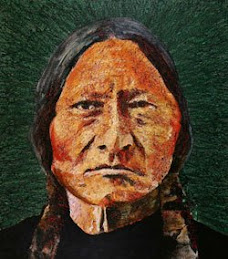





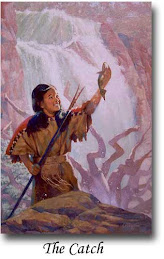

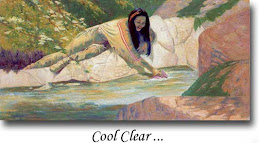

,+Peggy+O%27Neal.jpg)
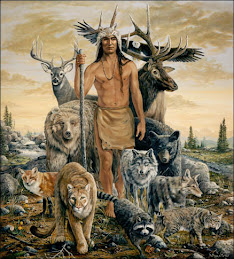,+Peggy+O%27Neal.jpg)
,+Peggy+O%27Neal.jpg)
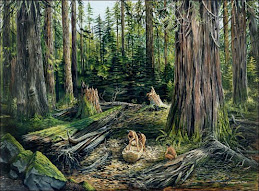,+Peggy+O%27Neal.jpg)


